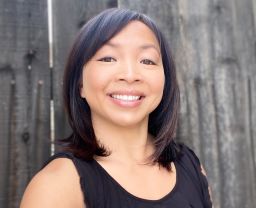Editor’s note: Lynda Lin Grigsby is a journalist and editor who has written for a number of national news outlets. She is a former editor of the Pacific Citizen, a national Asian American newspaper. The views expressed here are her own. Read more opinion at CNN.
In my middle school in California, the book “I, Columbus: My Journal 1492 — 1493” was required reading. The fictional account is written in a first-person diary format that aims to humanize the person behind the famous name.
The journal entries recount the explorer’s fear of mutiny by his own crew after having spent weeks lost at sea. I imagine that if he and my dad had a conversation, my dad would say, “Same, Columbus, same.”

In high school a few years later, my Chinese Vietnamese parents’ entire forced migration story was compressed into two paragraphs of my history textbook. Under the subheading of “The Vietnam War,” I learned about the boat people’s plight through that paltry text and a singular emblematic photo of faces, young and old, staring up at their assumed rescuers from a wooden boat.
This is where my family history was stuck for a long time — prostrate at sea and afforded only a few sentences in the hardcover book with hundreds of pages of history that didn’t feel like mine to claim. Unlike other illustrative depictions of passages to the US that cast their seafarers as heroic, Vietnamese boat people are forever portrayed as victims and sidebars to the main narrative.
My parents rarely spoke of the difficult journey that led them to settle in the United States. I knew only the most cursory details about their tending to my crying, seasick brother while other passengers bitterly threatened to throw him out of a boat crammed with refugees.
My family’s journey is very much a part of American history, part and parcel with the Vietnam War, a singular event that caused a dispersion of ripples. I am one of those ripples. I am here because of US imperial intervention and President Jimmy Carter’s signing of the Refugee Act of 1980.
All immigrant and refugee narratives, including my parents’ stories, contribute to the unfolding of American history. These very American experiences deserve space beyond the distillation into a couple of paragraphs in a textbook.
Like most survival stories, my family’s journey didn’t end with the sighting of land. It encompassed the grit of the travelers but also the profound humanity of a host nation lifting up newcomers fleeing a bleak existence.
Americans pause in reflection during holidays such as Independence Day to celebrate this very same ethos. It would be a good thing if Americans were also taught more about the histories, cultures and experiences of marginalized communities. That would only help us better understand our friends and neighbors.
The push for more college-level Asian American studies programs is growing. This year, the University of New Mexico offered its first introductory Asian American studies course, and Duke University graduated its first cohort of Asian American studies minors.
This is progress, but still not enough. Fewer than 100 American colleges and universities offer Asian American studies programs or degrees, according to data from the Association for Asian American Studies. If we acknowledge immigrant and refugee stories as an important part of American history, we can’t relegate them exclusively to college-level specialty programs.
“Not everyone has access to college,” Evyn Lê Espiritu Gandhi, an assistant professor at UCLA in the Asian American Studies Department, told me. At UCLA, Gandhi teaches a class called Critical Refugee Studies, which centers on refugee voices.
“The course asks: What can we learn when we stop and really listen to refugee stories and perspectives?” Gandhi said.
In the first half of 2023, some 2,000 migrants have died at sea trying to reach Europe, hundreds more than perished during the same journey during the same period last year, according to researchers at the UN International Organization for Migration.
Photos of the migrants at sea crowded into boats look all too familiar — different times and geopolitical circumstances but similar facial expressions of despair and hope.
Get Our Free Weekly Newsletter
- Sign up for CNN Opinion’s newsletter
- Join us on Twitter and Facebook
My home state of California seeks to answer the question about what we can learn when we really listen to refugee stories by leading the effort to require ethnic studies for public high school students by 2030. This is not to say that the complexities of forced migration can easily be smoothed over just by active listening, but what it can do is create human connections. Those faces floating out at sea are mothers, children and beloved family members.
I am the beneficiary of an Asian American studies degree — after stumbling upon the subject accidentally in college while pursuing an English literature degree. But I often wonder what it would have been like if I had learned about the whole story of the Vietnamese boat people earlier.
What if in addition to “I, Columbus,” middle school and high school students such as me had also read “The Best We Could Do” and “The Boy at the Back of the Class”? What if more students were challenged to make connections between their lives and people who endure long bus rides ostensibly as political pawns?
Asian American and ethnic studies can help us better understand our friends and neighbors — and ourselves as well. They are not fringe specialization studies that can wait for college. In our ongoing national conversation about whose histories count in the broader American narrative, it is important to remember that in a country as big and broad and diverse as ours, there is room for more than just one story.





